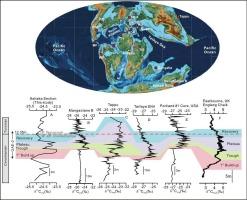Global redox and bio-productivity changes during the oceanic anoxic event 2 (OAE2): Insights from combined U-C isotopes of the Trans-Saharan epicontinental Seaway
IF 7.2
1区 地球科学
Q1 GEOSCIENCES, MULTIDISCIPLINARY
引用次数: 0
Abstract
The Cenomanian-Turonian boundary marks a global ocean anoxic event (OAE2), leading to the widespread deposition of black-shales due to enhanced primary productivity and O2 consumption. However, recent studies predict contradictory redox conditions from the open ocean to the epicontinental seas. This study combined existing C and U isotopic compositions of marine OAE2-bearing sediments to understand global redox-variations better and introduce the previously overlooked Trans-Saharan Epicontinental Seaway. We examined the first integrated geochemical dataset from the Ashaka section, Nigeria, including δ13Corg, δ238U, TOC, redox-sensitive and bio-essential trace metal concentrations in authigenic sediments. We propose the potential location of the OAE2 and reconstruct local variations in redox and bio-productivity in the Trans-Saharan Seaway. The chemo-stratigraphic onset of the OAE2 is marked by a globally occurring positive δ13Corg excursion (−25.5 to –23.5‰). However, unlike many OAE2 sections (e.g., Tarfaya Basin and Demerara Rise in the N.-Atlantic), exhibiting high TOC, the Trans-Saharan Seaway records low TOC, comparable to the Western Interior Seaway and the Paleo-Pacific Ocean. These differences indicate poor regional preservation, contrasting with organic-rich, marine-dominated preservation in the deeper Tarfaya Basin and N. Atlantic. Micro-to-macronutrient ratios in the Trans-Saharan Seaway were low during the OAE2, suggesting suppressed productivity akin to the Western Interior Seaway and differing from the high-productivity regimes in the Tarfaya Basin and Tethys Sea. Furthermore, redox conditions highlight regional contrasts: predominantly oxic-suboxic conditions in the Trans-Saharan and Western Interior Seaway and Paleo-Pacific Ocean vs. anoxic in the Gubbio section and Demerara Rise. Despite partially oxygenated conditions, a negative δ238Usw shift in the Trans-Saharan Seaway (−1.6‰) mirrors the Demerara Rise, Eastbourne, Western Interior Seaway, and Morelos Formation. However, the magnitude varies globally, with epicontinental seaways recording the largest shifts. These inconsistencies suggest that the extent of ocean anoxia undulates across basins calling for a cautious interpretation of U isotopes as a global redox proxy.

海洋缺氧事件2 (OAE2)期间全球氧化还原和生物生产力的变化:来自跨撒哈拉大陆表层海道U-C组合同位素的见解
Cenomanian-Turonian边界标志着全球海洋缺氧事件(OAE2),由于初级生产力和氧气消耗的增加,导致黑色页岩的广泛沉积。然而,最近的研究预测了从公海到陆表海的相互矛盾的氧化还原条件。该研究结合了海洋含oae2沉积物的现有C和U同位素组成,以更好地了解全球氧化还原变化,并介绍了以前被忽视的跨撒哈拉大陆表层海道。我们研究了尼日利亚Ashaka剖面的第一个综合地球化学数据集,包括自生沉积物中的δ13Corg、δ238U、TOC、氧化还原敏感和生物必需微量金属浓度。我们提出了OAE2的潜在位置,并重建了跨撒哈拉海道氧化还原和生物生产力的局部变化。OAE2的化学地层起升标志着全球正δ13Corg偏移(- 25.5 ~ -23.5‰)。然而,与许多OAE2剖面(如北大西洋的Tarfaya盆地和Demerara隆起)表现出高TOC不同,跨撒哈拉海道的TOC记录较低,与西部内陆海道和古太平洋相当。这些差异表明,与塔尔法亚盆地和北大西洋深层富含有机物、以海洋为主的保存相比,区域保存较差。在OAE2期间,跨撒哈拉海道的微量营养素与宏量营养素之比很低,表明生产力受到抑制,类似于西部内陆海道,与Tarfaya盆地和Tethys海的高生产力制度不同。此外,氧化还原条件突出了区域差异:跨撒哈拉和西部内陆海道和古太平洋主要是缺氧条件,而古比奥剖面和德梅拉拉隆起则是缺氧条件。在部分含氧条件下,跨撒哈拉海道的负δ238Usw移动(- 1.6‰)反映了Demerara隆起、Eastbourne、西部内陆海道和Morelos组。然而,其幅度在全球范围内有所不同,陆表海道记录的变化最大。这些不一致表明,海洋缺氧的程度在盆地之间波动,要求对U同位素作为全球氧化还原代理进行谨慎的解释。
本文章由计算机程序翻译,如有差异,请以英文原文为准。
求助全文
约1分钟内获得全文
求助全文
来源期刊

Gondwana Research
地学-地球科学综合
CiteScore
12.90
自引率
6.60%
发文量
298
审稿时长
65 days
期刊介绍:
Gondwana Research (GR) is an International Journal aimed to promote high quality research publications on all topics related to solid Earth, particularly with reference to the origin and evolution of continents, continental assemblies and their resources. GR is an "all earth science" journal with no restrictions on geological time, terrane or theme and covers a wide spectrum of topics in geosciences such as geology, geomorphology, palaeontology, structure, petrology, geochemistry, stable isotopes, geochronology, economic geology, exploration geology, engineering geology, geophysics, and environmental geology among other themes, and provides an appropriate forum to integrate studies from different disciplines and different terrains. In addition to regular articles and thematic issues, the journal invites high profile state-of-the-art reviews on thrust area topics for its column, ''GR FOCUS''. Focus articles include short biographies and photographs of the authors. Short articles (within ten printed pages) for rapid publication reporting important discoveries or innovative models of global interest will be considered under the category ''GR LETTERS''.
 求助内容:
求助内容: 应助结果提醒方式:
应助结果提醒方式:


